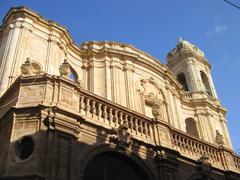Visiting Grotta Mangiapane: Hours, Tickets, and History in Erice, Italy
Date: 18/07/2024
Introduction
Today, Grotta Mangiapane is an open-air museum, a testament to the enduring relationship between humanity and the natural world. It attracts visitors year-round, offering a journey through time that resonates with history, culture, and the spirit of human resilience. This guide provides comprehensive coverage of the site’s historical significance, visitor information, and travel tips to help you make the most of your visit to Grotta Mangiapane.
Table of Contents
- Introduction
- Early Inhabitants and Prehistoric Significance
- The Mangiapane Family and the Birth of a Community
- Abandonment and Rediscovery
- Visitor Information
- Nearby Attractions
- The Living Nativity - A Cherished Tradition
- Conclusion
- FAQ
Early Inhabitants and Prehistoric Significance
The story of Grotta Mangiapane stretches back to the Paleolithic era, with archaeological evidence pointing to its use by prehistoric communities around 10,000 years ago. These early inhabitants, drawn to the cave’s natural shelter and proximity to resources, left behind traces of their presence in the form of stone tools, pottery fragments, and animal bones. These artifacts, unearthed through meticulous archaeological excavations, provide invaluable insights into the lives and practices of these ancient people, highlighting their ingenuity in adapting to the challenges of their environment.
The Mangiapane Family and the Birth of a Community
In the 19th century, Grotta Mangiapane became home to the Mangiapane family, who transformed this natural shelter into a thriving, albeit unusual, village. This unique community, led by the patriarch Andrea Mangiapane, carved out a life within the cave’s embrace, constructing small dwellings, a bakery, a chapel, and even a stable for their animals.
Abandonment and Rediscovery
By the mid-20th century, the allure of modernity and the challenges of life within the cave led to the gradual abandonment of Grotta Mangiapane. The once-thriving village fell silent, its story fading into the realm of local legend. However, the cave’s historical and cultural significance did not remain hidden for long. Rediscovered and recognized for its unique heritage, Grotta Mangiapane underwent a period of careful restoration, transforming it into the captivating open-air museum it is today.
Visitor Information
Visiting Hours and Ticket Prices
Grotta Mangiapane is open to visitors year-round, with varying hours depending on the season. During the summer months, the site is typically open from 9 AM to 7 PM, while in the winter, hours may be reduced to 10 AM to 5 PM. Tickets can be purchased at the entrance or online, with prices ranging from €5 for adults to €3 for children and seniors. Group discounts are also available.
Accessibility Information
The site is partially accessible to visitors with mobility impairments. While some areas of the cave and village are uneven and may present challenges, efforts have been made to accommodate all visitors. It is recommended to contact the site in advance for specific accessibility inquiries.
Travel Tips
Grotta Mangiapane is located near the town of Custonaci, approximately 20 kilometers from Erice. Visitors can reach the site by car, with parking available nearby. Public transportation options include buses from Erice and Trapani. It is advisable to wear comfortable walking shoes and bring water, especially during the warmer months.
Nearby Attractions
Erice
The ancient town of Erice, with its medieval castles and cobblestone streets, offers a charming glimpse into Sicily’s past.
Zingaro Nature Reserve
The Zingaro Nature Reserve, with its stunning coastal trails and diverse wildlife, is another must-see destination for nature enthusiasts.
Trapani
Explore the coastal city of Trapani, known for its historic salt pans, vibrant old town, and access to the beautiful Egadi Islands.
Cornino Nature Reserve
The Cornino Nature Reserve offers opportunities for hiking, birdwatching, and enjoying the crystal-clear waters of the Mediterranean.
The Living Nativity - A Cherished Tradition
Beyond its historical significance, Grotta Mangiapane is renowned for its annual “Presepe Vivente” or Living Nativity scene. This cherished tradition, held during the Christmas season, transforms the cave into a breathtaking spectacle. Local residents, dressed in period costumes, reenact the Nativity story, bringing the cave to life with music, light, and the spirit of the season. The Living Nativity at Grotta Mangiapane is not merely a performance; it is a deeply moving experience that connects visitors to the cave’s rich history and the enduring power of tradition.
Conclusion
FAQ
Q - What are the visiting hours for Grotta Mangiapane? A - Grotta Mangiapane is typically open from 9 AM to 7 PM in the summer and 10 AM to 5 PM in the winter. Check the official website for the most current hours.
Q - How much do tickets cost to visit Grotta Mangiapane? A - Ticket prices are approximately €5 for adults and €3 for children and seniors. Group discounts are available.
Q - Is Grotta Mangiapane accessible to visitors with mobility impairments? A - The site is partially accessible. Some areas may present challenges, so it’s best to contact the site in advance for specific accessibility information.
Q - What is the best way to get to Grotta Mangiapane? A - The site is near Custonaci, about 20 kilometers from Erice. Visitors can reach it by car or public transportation from Erice and Trapani.
Q - What nearby attractions should I visit? A - Nearby attractions include the ancient town of Erice and the Zingaro Nature Reserve.
